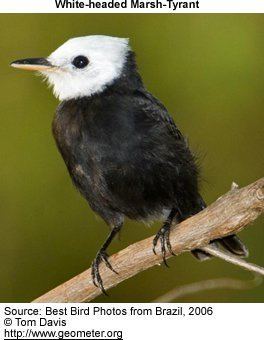Scientific name Arundinicola leucocephala Higher classification Arundinicola Order Passerine | Family Tyrannidae Phylum Chordata Rank Species | |
 | ||
Genus Arundinicolad'Orbigny, 1840 Similar Fluvicola, Yellow tyrannulet, Myiophobus, Pied water tyrant, Streamer‑tailed tyrant | ||
The white-headed marsh tyrant (Arundinicola leucocephala) is a small passerine bird in the tyrant flycatcher family, the only species of the genus Arundinicola. It breeds in tropical South America from Colombia, Venezuela and Trinidad south to Bolivia, Argentina and Paraguay.
Contents
- White headed marsh tyrant arundinicola leucocephala freirinha family tyrannidae
- Description
- Diet
- References

White headed marsh tyrant arundinicola leucocephala freirinha family tyrannidae
Description

The adult white-headed marsh tyrant is 12.7 cm long and weighs 15 g. The male is entirely brown-black, apart from the relatively large white head and yellowish lower mandible. The female has brown upperparts and wings and a black tail. Her underparts, sides of the head and forecrown are dull white. This is a quiet species, but the call is a sharp sedik.
This species is found in marshy savannahs, reedbeds and the edges of mangrove swamps.
Diet

White-headed marsh tyrants wait on an exposed low perch in marsh vegetation or a branch near water, occasionally sallying out to feed on insects, their staple diet, before returning to the perch. They often pick off insects from the vegetation, but more frequently out of mid-air and even from shallow water.

The nest is a feather-lined oval ball of grasses and other plant material, with a porched side entrance. It is placed at the end of a branch near or over water. Both sexes incubate the typical clutch of two or three creamy-white eggs, which are marked with a few brown spots. Cowbirds often parasitise the nest.
This bird is not considered threatened by the IUCN. Local populations may disappear however due to declining habitat quality.
